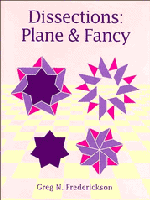Book contents
- Frontmatter
- Contents
- Preface
- 1 “Dat Pussle”
- 2 Our Geometric Universe
- 3 Fearful Symmetry
- 4 It's Hip to Be a Square
- 5 Triangles and Friends
- 6 All Polygons Created Equal
- 7 First Steps
- 8 Step Right Up!
- 9 Watch Your Step!
- 10 Just Tessellating
- 11 Plain Out-Stripped
- 12 Strips Teased
- 13 Tessellations Completed
- 14 Maltese Crosses
- 15 Curves Ahead
- 16 Stardom
- 17 Farewell, My Lindgren
- 18 The New Breed
- 19 When Polygons Aren't Regular
- 20 On to Solids
- 21 Cubes Rationalized
- 22 Prisms Reformed
- 23 Cheated, Bamboozled, and Hornswoggled
- 24 Solutions to All Our Problems
- Afterword
- Bibliography
- Index of Dissections
- General Index
21 - Cubes Rationalized
Published online by Cambridge University Press: 05 August 2012
- Frontmatter
- Contents
- Preface
- 1 “Dat Pussle”
- 2 Our Geometric Universe
- 3 Fearful Symmetry
- 4 It's Hip to Be a Square
- 5 Triangles and Friends
- 6 All Polygons Created Equal
- 7 First Steps
- 8 Step Right Up!
- 9 Watch Your Step!
- 10 Just Tessellating
- 11 Plain Out-Stripped
- 12 Strips Teased
- 13 Tessellations Completed
- 14 Maltese Crosses
- 15 Curves Ahead
- 16 Stardom
- 17 Farewell, My Lindgren
- 18 The New Breed
- 19 When Polygons Aren't Regular
- 20 On to Solids
- 21 Cubes Rationalized
- 22 Prisms Reformed
- 23 Cheated, Bamboozled, and Hornswoggled
- 24 Solutions to All Our Problems
- Afterword
- Bibliography
- Index of Dissections
- General Index
Summary
In the twilight of his career at Cambridge University, Herbert W. Richmond combined his lifelong interests in geometry and number theory to pose one of the more natural of puzzles in solid dissections: Dissect cubes of edge lengths 3, 4, and 5 to give a cube of edge length 6. The venerable octogenarian produced a dissection with some appealing symmetries, but it used twelve pieces – a rather generous number.
Six years later, John Leech, then a student at Cambridge, latched onto the problem. He challenged the readers of Eureka, the Cambridge undergraduate math journal, to find a dissection that used at most ten pieces, an improvement of two over Richmond's solution. And within a year, the charge of that young generation was complete. Roger Wheeler, also an undergraduate at Cambridge, responded with a dissection that reduced the number of pieces even further, again by two, down to eight!
What colossal impertinence in that young generation at Cambridge! Or was it just a colossal impatience, given the few solid dissection problems that had been posed and solved? Surely it was implacability in the face of problems that seemed so much more difficult than their two-dimensional analogues. It had been a natural step for Richmond (1943) to pose the dissection for cubes realizing 33 + 43 + 53 = 63. And considering that there were no previous dissections for any solution to x3 + y3 + z3 = w3, twelve pieces might have seemed a veritable bargain.
Information
- Type
- Chapter
- Information
- DissectionsPlane and Fancy, pp. 247 - 257Publisher: Cambridge University PressPrint publication year: 1997
